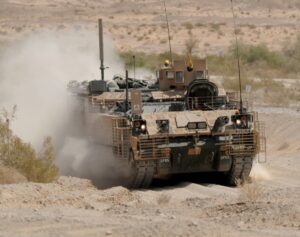After requesting $380.7 million to buy 72 Armored Multi-Purpose Vehicles (AMPV) in its fiscal year 2023 budget, new documents detail the service’s plan to buy 131 vehicles for just over $680 million annually starting in FY ‘24 through FY ‘27.
Details of the Army’s proposed AMPV procurement plan, which is set to ramp up in FY ‘23 after the original production schedule was re-baselined, were included in justification books released this week to accompany the service’s $178 billion budget request.

The BAE Systems-built AMPV is the Army’s replacement for its legacy M113 armored personnel carriers, with the program set to move into initial operational test and evaluation this year.
The new budget documents note the unit price for AMPVs has increased “due to strong inflationary pressures on commodity prices, reusable parts supply expended from exchange vehicles during [low-rate initial production] and purchasing AMPVs at a lower production rate than in the past.”
Officials in the budget documents note the Army has 457 AMPVs on contract with BAE Systems to date, with an overall acquisition objective for 2,897 vehicles.
The Army on April 4 said soldiers have recently evaluated a new armored turret system for the AMPV developed by engineers from the service’s Combat Capabilities Development Command Armaments Center at Picatinny Arsenal in New Jersey.
The new Objective Commander’s Weapon Station (OCWS) is designed to integrate with all five AMPV variants, according to the Army, with the system having undergone reliability testing at Yuma Proving Ground in Arizona and live-fire testing at Aberdeen Proving Ground in Maryland.
“The OCWS is definitely one of our more sophisticated turret systems,” Thomas Kiel, the Armaments Center’s lead for engineering activity for Army and Marine Corps armored and tactical vehicle turrets, said in a statement. “The AMPV was developed to operate on the front lines of the battlefield, and our team had to accommodate the challenging requirements associated with that.”
The Army said the Armaments Center provided 20 OCWS turrets for test and evaluation, describing the prototype system as offering a “combination of opaque and transparent armor that is specially configured to provide advanced protection and situational awareness.”
“We built all of the prototype OCWS turrets in-house over the last 18 months,” Narayan Bhagavatula, program lead for gunner protection systems with the Army’s Program Manager Soldier Lethality based in Picatinny Arsenal, said in a statement. “Meeting the aggressive test schedule was a top priority, along with finalizing the technical data package for the start of [AMPV] low-rate production.”